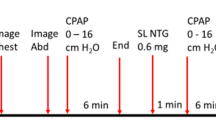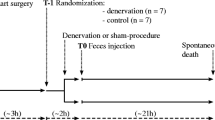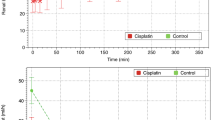Abstract
The thiobutabarbitone(TB, Inactin)-anaesthetised rat is an extremely widely used preparation for the study of renal function at the whole-organ and nephron levels. The recent withdrawal of TB from the market has made it essential to find an anaesthetic producing experimental conditions as similar as possible to TB to allow comparison of past and future data. Blood gas analysis, clearance and micropuncture studies were therefore performed in rats anaesthetised with TB or the related thiobarbiturate thiopentone (TP) (both 100 mg/ kg body weight) to establish whether the latter meets this requirement. Both barbiturates caused similar transient respiratory depression and acidosis. Mean values (TP versus TB) over the total 8-h observation period for glomerular filtration rate (0.94 versus 1.05 ml/min), urine flow (3.8 versus 4.4 μl/min) and K+ excretion (0.98 versus 1.18 μmol/min) were slightly lower (P<0.05) in TP rats, whereas renal blood flow (6.26 versus 6.24 ml/min), filtration fraction (0.31 versus 0.34) and Na+ excretion (0.11 versus 0.098 μmol/min) did not differ. The single-nephron filtration rate (SNGFR) (42.1 versus 41.1 nl/min) and fractional reabsorption (42% versus 47%), both measured in the proximal tubule, did not differ, although in the TP group SNGFR rose with time (4.4%/h) whereas the fractional reabsorption did not change significantly; in the TB group SNGFR was constant but fractional reabsorption declined with time (1.5%/h). Fractional reabsorption up to the distal convoluted tubule declined with time, this was more pronounced in the TP group. SNGFR measured at this site did not differ between TP and TB (30.3 versus 30.1 nl/min) but increased with time with TP (2.7%/h). Although renal function under TP is somewhat less stable than under TB, the differences are minor and, given that the latter is also characterised by non-steady-state conditions, it is concluded that TP is a reasonable replacement for TB.
Similar content being viewed by others
References
Aldridge WN, Parker VH (1960) Barbiturates and oxidative phosphorylation. Biochem J 76:47–56
Bar-Ilan A, Marder J (1980) Acid base status in unanaesthetized unrestrained guinea pigs. Pflügers Arch 384:93–97
Burn JH, Hobbs R (1959) Mechanism of arterial spasm following intraarterial injections of thiopentone. Lancet I:1112–1115
Change B, Hollunger KG (1963) Inhibition of energy and electron transfer in mitochondria. J Biol Chem 238:418–431
Chen CF, Chapman BJ, Munday KA (1985) The effect of althesin, ketamine or pentothal on renal function in saline loaded rats. Clin Exp Pharmacol Physiol 12:99–105
Christensen P, Kristensen LO, Leyssac PP (1973) The effects of amytal and inactin on isosmotic net fluid transport in the rabbit gall bladder in vitro. Acta Physiol Scand 87:455–464
Davis JM, Häberle DA, Kawata T, Schmitt E, Takabatake T, Wohlfeil S (1988) The increase of tubuloglomerular feedback mediated suppression of GFR during acute volume expansion in rats. J Physiol (Lond) 395:553–576
Dev B, Häberle DA, Schnermann J, Wunderlich P (1973) Effect of barbiturates on GFR and fluid reabsorption along proximal tubules and loops of Henle in rats. Pflügers Arch 344:21–32
Ebling WF, Danhof M, Stanski DR (1991) Pharmacodynamic characterization of the electroencephalographic effects of thiopental in rats. J Pharmacokinet Biopharm 19:123–143
Frey HH (1959) Vergleichende Untersuchungen zum Stoffwechsel intravenöser Kurznarkotika. Arch Int Pharmacodyn Ther 118:12–61
Frey HH (1961) Narkotische Wirksamkeit, Toxizität und Wirkungsdauer von Butabarbital und seinen N-Methyl-, Thio- und N-Methyl-thio-Analogen. Arch Int. Pharmacodyn Ther 132:164–171
Frey HH, Doenicke A, Jäger G (1961) Quantitative Bedeutung der Desulfierung im Stoffwechsel von Thiobarbituraten. Med Exp 4:243–250
Häberle DA, Ruhland G (1976) Inactin concentration in plasma of rats during anaesthesia and the effect of this concentration on short circuit current of isolated frog skin. Pflügers Arch 365:77–80
Harvey SC (1975) Hypnotics and sedatives. In: Goodman LS, Gilman AG (eds) The pharmacological basis of therapeutics, 5th edn. Macmillan, New York, pp 102–123
Kaczmarczyk G, Reinhardt HW (1975) Arterial blood gas tensions and acid-base status of Wistar rats during thiopental and halothane anesthesia. Lab Anim Sci 25:184–190
Lai YL, Tsuya Y, Hildebrandt J (1978) Ventilatory responses to acute CO2 exposure in the rat. J Appl Physiol 45:611–618
Marshall BE, Longnecker DE (1990) General anesthetics. In: Gilman AG, Rall TW, Nies AS, Taylor P (eds) The pharmacological basis of therapeutics, 8th edn. Pergamon Press, New York, pp 285–310
Mercer PF, Kline RL (1990) The influence of renal nerves on electrolyte excretion in conscious and anesthetized rats fed or fasted overnight. Can J Physiol Pharmacol 68:524–530
Michael UF, Kelley J, Meeks LA, Vaamonde CA (1981) Renal acidification in the hypothyroid rat. Evaluation by urinary CO2 tension. Can J Physiol Pharmacol 59:273–280
Ohmura A, Wong KC, Pace NL, Johansen RK (1982) Effects of halothane and sodium nitroprusside on renal function and autoregulation. Br J Anaesth 54:103–108
Olsen EB, Dempsey JA (1978) Rat as a model for humanlike ventilatory adaptation to chronic hypoxia. J Appl Physiol 44:763–769
Pavlin EG, Hornbein TF (1986) Anesthesia and the control of respiration. In: Cherniak NS, Widdicombe JG (eds) The respiratory system, vol. 2, part 2 (Handbook of physiology, sect 3). American Physiological Society, Bethesda Md, pp 793–814
Pepelko WE, Dixon GA (1975) Arterial blood gases in conscious rats exposed to hypoxia, hypercapnia, or both. J Appl Physiol 38:581–587
Severinghaus JW, Larson CP (1965) Respiration in anesthesia. In: Fenn WO, Rahn H (eds) Respiration. (Handbook of physiology, sect 3, vol 2). American Physiological Society, Bethesda, Md, pp 1219–1264
Shirley DG, Walter SJ, Zewde T (1989) Measurement of renal function in unrestrained conscious rats. J Physiol (Lond) 408:67–76
Tucker BJ, Mundy CA, Ziegler MG, Baylis C, Blantz RC (1987) Head-down tilt and restraint on renal function and glomerular dynamics in the rat. J Appl Physiol 63:505–513
Walker LA, Buscemi-Bergin M, Gellai M (1983) Renal hemodynamics in conscious rats: effect of anesthesia, surgery, and recovery. Am J Physiol 245:F67-F74
Walter SJ, Zewde T, Shirley DG (1989) The effect of anaesthesia and standard clearance procedures on renal function in the rat. Q J Exp Physiol 74:805–812
Waynforth HB (1980) Experimental and surgical technique in the rat. Academic Press, London, pp 95–102
Author information
Authors and Affiliations
Rights and permissions
About this article
Cite this article
Häberle, D.A., Davis, J.M., Kawabata, M. et al. Renal and single-nephron function is comparable in thiobutabarbitone- and thiopentone-anaesthetised rats. Pflügers Arch. 424, 224–230 (1993). https://doi.org/10.1007/BF00384346
Received:
Revised:
Accepted:
Issue Date:
DOI: https://doi.org/10.1007/BF00384346




